Olympus E-5 Review
Olympus E-5 Introduction
The Olympus E-5 is a very feature-rich DSLR aimed at professional users. This Four-Thirds camera is built around a 12 megapixels LiveMOS sensor capable of 5 FPS continuous shooting, ISO sensitivities up to 6400 and 720p HD video recording. Its built-in stabilization system claims up to 4 stops of advantage over hand-holding. These core features are packed in a large professional-grade body with dual-control dials, a 100% coverage viewfinder and top-notch weather-sealing.
This new Olympus flagship DSLR has one of the most complete feature sets among DSLRs and a number of rare and unique capabilities. It inherits features of previous Olympus DSLR including a dual-axis digital-level, dust-reduction, live-view, a rotating rear LCD, an illuminated status display and dual memory-card slots. While the E-5 resembles its predecessor, the E-3, the new sensor changes quite a few key specifications. The biggest change being the addition of video capability with internal mono sound or external stereo sound recording. A larger LCD with four times higher resolution brings the E-5 up to par with other modern offerings.
This detailed review takes a close look at the Olympus E-5 in terms of features, ergonomics, usability, performance, image quality and photographic controls. As their new flagship DSLR, the E-5 sports the following features:
- 12 Megapixels image sensor with 4:3 aspect ratio.
- Four-Thirds mount with 2X crop-factor.
- Built-in image stabilization.
- Built-in dust-reduction.
- Dual-axis digital level.
- Automatic and selectable ISO from 100 to 6400.
- 1/8000s to 60s shutter-speeds, plus bulb up to 30 minutes.
- 11-point dual-cross auto-focus system.
- Focus point selection: automatic among 11, automatic among 5 or single-point.
- Focus modes: single-shot, continuous, manual, single DMF and continuous DMF.
- Automatic, preset, kelvin and custom white-balance.
- While-balance fine-tuning in 15 steps along 2 axis.
- Image parameters: Contrast, Sharpness, Saturation, adjustable in 5 steps.
- Gradation options: auto, normal, high-key and low-key.
- Full manual controls, PASMB exposure modes.
- Metering modes: multi-segment, center-weighed, spot, highlight spot and shadow spot.
- Exposure compensation, -5..+5 EV, in 1/3, 1/2 or 1 EV increments.
- Flash compensation, -3..+3 EV, in 1/3, 1/2 or 1 EV increments.
- Built-in popup flash, hot-shoe and sync-port for external lighting.
- 100% coverage 1.15X magnification viewfinder.
- Rotating 3” LCD with 920K Pixels.
- Image review with luminance and RGB histograms.
- Exposure bracketing: 2, 3 or 5, 0.3 to 1 EV increments, 7 frames 1/3 or 1/2 EV increments.
- White-Balance bracketing: 3 or 9 frames, 3 step sizes in each axis.
- ISO bracketing: 3 frames, 1/3, 2/3 or 1 EV steps.
- Flash bracketing: 3 frames, 1/2 or 1 EV steps.
- 5 FPS continuous drive, unlimited JPEG or 16 RAW.
- Self-timers: 12s and 2s
- Wired and infrared remote trigger: Instant or 2s delay.
- Mirror Lock-Up delay: 1/8 to 30s.
- Multiple exposure and RAW image blending, maximum 4 frames.
- 1280x720 @ 30 FPS 16:9 aspect-ratio movie-mode, with or without sound.
- Built-in mono or external stereo microphone for movie audio.
- Depth-of-field preview.
- Live-view.
- JPEG, RAW and JPEG+RAW modes.
- Configurable JPEG aspect ratio: 4:3, 16:9, 3:2, 1:1, 5:4, 7:6, 6:5, 7:5 and 3:4.
- Auto-Exposure-Lock (AEL) and Auto-Focus-Lock (AFL) button.
- Highly customizable buttons and dials.
- Dual control-dials.
- Weatherproof body.
- Illuminated top status panel.
- Lithium-ion battery.
- Compact Flash and Secure Digital Extended Capacity memory slots.
Olympus E-5 Suitability - What is it good for?
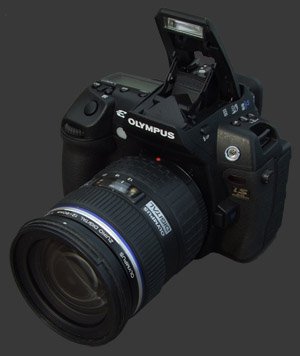 Since DSLR cameras represent the high-end of digital cameras, they are generally suitable for most types of photography. The versatility of interchangeable lenses brings SLR cameras their greatest potential. The Olympus E-5 is no exception, it is suitable for every type of photographic subject.
Since DSLR cameras represent the high-end of digital cameras, they are generally suitable for most types of photography. The versatility of interchangeable lenses brings SLR cameras their greatest potential. The Olympus E-5 is no exception, it is suitable for every type of photographic subject.
Feature-wise, the E-5 has just about everything. Other DSLR models distinguish themselves mostly by the choice of lenses available to them and ultimate performance. With a top continuous drive speed of 5 FPS, the E-5 is not among the fastest but it does manage to shoot continuously until a fast memory card fill up. The maximum ISO of 6400 may seem low compared to recent offerings but it is the usable range that matters the most, astronomical ISO sensitivities are rarely usable. What does work for low-light is the E-5's built-in stabilization system which, once combined with a fast lens, make it usable to extremely low light-levels.
For specific photographic subjects, lens versatility is most important. The Four-Thirds mount is relatively new and was specifically designed for digital cameras. This means that Four-Thirds lenses tend to be lighter, smaller and have brighter maximum apertures than comparable lenses for other systems. There are offerings from Olympus, under the Zuiko name, and third-party lenses from Sigma. Zuiko rectilinear lenses start at 7mm and reach 300mm, which is equivalent to an extremely wide 14mm and a rather long 600mm, respectively in 35mm-equivalent terms. This is suitable for most photographic subjects, although super-telephoto lenses are limited. The Zuiko system offers several unique lenses, including the world's only F/2 zooms.
The Olympus E-5 has a tough weather-sealed body that makes it more suitable for rough environments. When used with a compatible weather-proof lens, it can withstand rain, snow and dust without problems. This DSLR is larger than most and even heavier than some full-frame models. This means the E-5 is not ideal for candid and street photography. Dual memory card slots let this DSLR use all the most popular types of memory, including the fastest Compact-Flash cards and SDXC cards. Power is provided by a proprietary Lithium-Ion battery and an optional battery-grip which takes AAs for increased versatility.
Olympus E-5 Capability - What can it do?
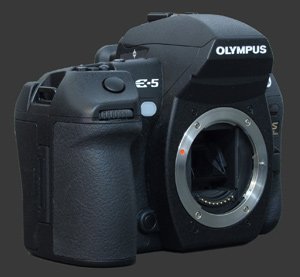 The Olympus E-5 is an extremely feature rich camera, with only two models to date offering most of the same features. Just like all DSLRs, this one offers full manual-controls, multiple metering modes, custom white-balance, manual focusing, control over image parameters, high-ISO capability, RAW shooting and a reflex optical viewfinder. As a professional-grade DSLR, the E-5 also has all the capabilities required by such cameras: dual control-dials, a 100% coverage viewfinder, a weather-sealed body, high-speed continuous drive, continuous autofocus, AEL/AFL, depth-of-field preview and spot-metering. These and other significant functions of the E-5 are covered in detail in this review section.
The Olympus E-5 is an extremely feature rich camera, with only two models to date offering most of the same features. Just like all DSLRs, this one offers full manual-controls, multiple metering modes, custom white-balance, manual focusing, control over image parameters, high-ISO capability, RAW shooting and a reflex optical viewfinder. As a professional-grade DSLR, the E-5 also has all the capabilities required by such cameras: dual control-dials, a 100% coverage viewfinder, a weather-sealed body, high-speed continuous drive, continuous autofocus, AEL/AFL, depth-of-field preview and spot-metering. These and other significant functions of the E-5 are covered in detail in this review section.
The 12 megapixels sensor in this DSLR can capture images suitable for high quality prints up to 20" x 15". This sensor complies with the Four-Thirds specifications and has a 4:3 aspect ratio with a 2X crop factor. This aspect-ratio is the same as non-widescreen displays and televisions and is slightly closer to a square than the standard 3:2 aspect ratio of most DSLRs. The ISO sensitivity can be automatically or manually set between 100 and 6400. The limit of Auto ISO is configurable in 1/3 EV stops from 200 to 6400 via a custom setup option. It defaults to ISO 1600.
The sensor is mounted on a movable plate which provides image stabilization for all lenses, regardless of focal-length and aperture. Not only is this a cost-saving feature, because the cost of stabilization is not incurred for each lens, but it also enables stabilization for lenses which have no stabilized counter-parts such as fast lensesLenses with a large maximum aperture such as F/2 or wider. and fisheye lenses. Combined with a maximum ISO of 6400 this can serve to take pictures in extremely low light. The sensor can also vibrate to shake off dust, a feature which Olympus pioneered and remains extremely effective but sticky dust can still require the occasional wet-cleaning.
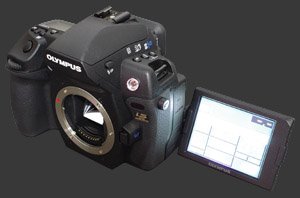 This DSLR has a P, A, S, M and B exposure modes. The shutter-speed range is 1/8000 to 60s in all modes except for bulb which supports exposures up to 30 minutes. This is comparable to high-end cameras and is suitable for ultra-fast action and low-light photography. Photographing star-trails can require even longer exposures which can be simulated using a technique called exposure-stacking as long as long-shutter noise-reduction is turned off to avoid a gap between consecutive exposures. There are 5 metering modes on the E-5: Multi-Segment, Center-Weighed, Spot, Highlight Spot and Shadow Spot. The first 3 are typically found on most cameras, the latter 2 are unique to Olympus. Highlight Spot lets one take a reading off of a highlight rather than a mid-tone grey. Shadow Spot lets one take a reading off a shadow area instead. The premise for these modes is simply that identifying what falls into a highlight or shadow where details are desired can be easier than identifying what is exactly a mid-tone. The Olympus E-5 also lets one bracket up to 7 frames of exposure, either shot-by-shot or continuously. It can also capture a 3-frame exposure-bracket by varying ISO or Flash power.
This DSLR has a P, A, S, M and B exposure modes. The shutter-speed range is 1/8000 to 60s in all modes except for bulb which supports exposures up to 30 minutes. This is comparable to high-end cameras and is suitable for ultra-fast action and low-light photography. Photographing star-trails can require even longer exposures which can be simulated using a technique called exposure-stacking as long as long-shutter noise-reduction is turned off to avoid a gap between consecutive exposures. There are 5 metering modes on the E-5: Multi-Segment, Center-Weighed, Spot, Highlight Spot and Shadow Spot. The first 3 are typically found on most cameras, the latter 2 are unique to Olympus. Highlight Spot lets one take a reading off of a highlight rather than a mid-tone grey. Shadow Spot lets one take a reading off a shadow area instead. The premise for these modes is simply that identifying what falls into a highlight or shadow where details are desired can be easier than identifying what is exactly a mid-tone. The Olympus E-5 also lets one bracket up to 7 frames of exposure, either shot-by-shot or continuously. It can also capture a 3-frame exposure-bracket by varying ISO or Flash power.
Colors can be rendered using an excessive variety of color modes, 18 actually. The is an iEnhance color mode which renders colors depending on the capture mode, usually producing dramatically over-saturated images. The more typical Vivid, Natural, Muted and Portrait modes are all there. The remaining modesMonotone, Custom, Pop Art, Soft Focus, Pale&Light Color, Light Tone, Granny Film, Pin Hole, Diorama, Cross Process, Gentle Sepia and Dramatic Tone are sometimes called Effects or Filters. These added modes feel out of place on such a high-end camera as advanced users prefer to leave irreversible effects out of their workflow. Each color mode has adjustable parameters of Contrast, Sharpness, Saturation and Gradation. There are 5 noticeable steps for each except Gradation which has 3 plus an Auto mode. Gradation refers to the overall brightness without affecting exposure, only affecting how colors are shown.
There are quite a few white-balance controls on this digital SLR. Auto mode uses an external white-balance sensor which measures light falling on the camera. There are also 7 presetsSunny, Shadow, Cloudy, Incandescent, Fluorescent, Underwater and Flash. There is a custom white-balance system with 4 memories. A custom option allows a button to be mapped to 'One-Touch White-Balance' which lets the camera quickly set a custom white-balance. White-balance can also be specified in Kelvin degrees. All white-balance settings are fine-tunable in 15 steps along 2 axis. There is also a white-balance virtual bracket which captures a single shot and saves it 3 or 9 times with different white-balances. This is controlled by choosing one or two axis and among three step sizes. When choosing two axis, the camera saves 9 images, giving all the possible adjustment combinations.
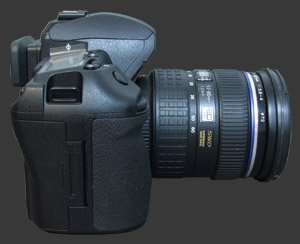 This DSLR has a fairly standard set of drive modes, which including continuous shooting at up to 5 FPS. A slower burst rate can also be chosen. There are 2s and 12s self-timer options which remain active after each use and after powering off the camera. The remote trigger is supported with immediate release or with 2 second delay. A custom menu enables the addition of an Anti-Shock delay up to 30 seconds. This is equivalent usually called Mirror Lock-Up (MLU). Bracketing is set separately from drive-mode and these two features combine intelligently. In continuous drive, the bracket is captured continuously while it is captured on shot at a time in single-shot mode. The E-5 also allows for multiple exposures of up to 4 frames. These images can be taken and accumulated in any file-format. There is an additional multiple-exposure trick which is to use a single previously captured RAW image as one of the images to combine.
This DSLR has a fairly standard set of drive modes, which including continuous shooting at up to 5 FPS. A slower burst rate can also be chosen. There are 2s and 12s self-timer options which remain active after each use and after powering off the camera. The remote trigger is supported with immediate release or with 2 second delay. A custom menu enables the addition of an Anti-Shock delay up to 30 seconds. This is equivalent usually called Mirror Lock-Up (MLU). Bracketing is set separately from drive-mode and these two features combine intelligently. In continuous drive, the bracket is captured continuously while it is captured on shot at a time in single-shot mode. The E-5 also allows for multiple exposures of up to 4 frames. These images can be taken and accumulated in any file-format. There is an additional multiple-exposure trick which is to use a single previously captured RAW image as one of the images to combine.
As expected from a top-of-the-line DSLR, this one features a hot-shoe and a sync-port for external lighting. There is also a built-in flash which can be automatically or manually powered. Automatic modes include Auto, Fill, Redeye, Slow Sync and Rear-Sync. Manually, power can be selected in 2 stop increments between full-power and 1/64th. There is also support for Olympus' own remote-controlled flash system. Flash compensation for the built-in flash can be set from -3 to +3 EV in 1/3 EV increments.
The Olympus E-5 claims to achieve the world's fastest autofocus speed using a very sensitive 11-point double-cross system. Each point is extremely sensitive to details in both vertical and horizontal orientation as well as fine local variations. The photographer can let the camera automatically choose the focus point among all 11 or among a chosen group of 5. Manual selection of the focus-point is also possible. The standard single-shot (AF-S), continuous (AF-C) and manual (MF) focus modes are all present, as well as two additional modes which allow manual focusing in an autofocus mode. The focusing system devised with the first Four-Thirds lenses used to be electronically driven using a fly-by-wire ring. This lets the E-5 decide which way to turn the ring to focus closer or further. Newer lenses, like most SWD lenses, have a loosely-coupled mechanically-linked ring instead. This means that the E-5 cannot set the focusing direction on those lenses, nor does it need to be told to allow quick-shift autofocus. You can always manually focus with such lens. This may get confusing if the focusing direction is reversed for anyone who owns both types of lenses. Another advantage of lenses with a mechanically-linked focus-ring is that they can be focused while the camera is powered off. This is not the case for lenses with fly-by-wire focusing since power is required to change the focus-distance.
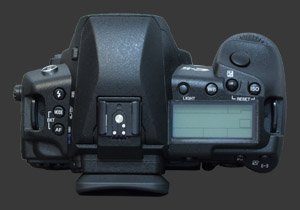 The is capable of previewing depth-of-field optically or digitally. In the former case, it simply stops down the lens which shows as increased depth-of-field through the viewfinder which becomes darker at the same time. In the latter, an image is captured and shown on the LCD screen without being saved. There is a built-in dual-axis digital-level which shows tilt and pitch independently for the camera in fine increments. Both axis are visible on the rear LCD using the Info button. The tilt axis is also visible in the viewfinder and on the top status LCD but it has to be activated and disactivated via the push of a button.
The is capable of previewing depth-of-field optically or digitally. In the former case, it simply stops down the lens which shows as increased depth-of-field through the viewfinder which becomes darker at the same time. In the latter, an image is captured and shown on the LCD screen without being saved. There is a built-in dual-axis digital-level which shows tilt and pitch independently for the camera in fine increments. Both axis are visible on the rear LCD using the Info button. The tilt axis is also visible in the viewfinder and on the top status LCD but it has to be activated and disactivated via the push of a button.
The last major feature of the E-5 is a 720p HD video mode which produces widescreen 16:9 aspect video at 30 FPS. Videos are saved as AVI files using the M-JPEG codec up to 2 GB in size. Sound can optionally be recorded along with the video. The camera can either use its built-in mono microphone or an external stereo input. Exposure during videos is either fully automatic in P or S mode, semi-automatic in A mode or fully manual in M mode. For obvious reasons, the shutter-speed cannot go below 1/30s while recording video. ISO can be set anywhere between 200 and 1600 but this only takes effect in Manual mode.
 |
Please Support Neocamera
All information on Neocamera is provided free of charge yet running this website is a huge endeavor. Purchases made via affiliate links found throughout the site help keep it running and up-to-date. There is no additional cost to you, so please consider buying via these links to our affilates:
If you found any information on this site valuable and did not purchase via our affiliate links, please considering donating via PayPal:
Any amount will be greatly appreaciated. Thank you for your support!
Olympus E-5 Highlights

Sensor-Size: 17 x 13mm

Actual size when viewed at 100 DPI
| 12 Megapixels DSLR | ISO 100-6400 |
| Four-Thirds Mount 2X FLM | Shutter 1/8000-60s |
| 2-Axis Built-in Stabilization | Full manual controls, including Manual Focus |
| 100% Coverage Medium Viewfinder | Custom white-balance with 2 axis fine-tuning |
| 2 Axis Digital Level | Spot-Metering |
| Weatherproof | Hot-Shoe |
| Built-in Dust Reduction | Stereo audio input |
| 5 FPS Drive, Unlimited Images | Lithium-Ion Battery |
| 1280x720 @ 30 FPS Video Recording | Secure Digital Extended Capacity, Compact Flash |
| 3" LCD 920K Pixels |
Updates
2024.11.18

Best 2024 Photography Gifts for Every Budget
Great gifts for photographers and photo enthusiasts selected for every budget among the best products of 2024.
2024.08.07

Eye Protection Tips for Professional Photographers
The four main considerations for professional photographers regarding eyewear.
2024.07.14

Fujifilm X100VI Review
Flagship fixed-lens compact digital camera with a 40 MP sensor and Image-Stabilization, a first for the series. Retro design featuring dual control-dials, plus direct ISO, Shutter-Speed and EC dials. Its hybrid viewfinder can switch between EVF and OVF mode.
2024.05.09

Fujifilm GFX100 II Review
Flagship 102 Megapixels Medium-Format Mirrorless Digital Camera with 8-Stop 5-Axis IBIS, 8 FPS Drive, 8K Video and 400 MP Super-Resolution capture in a weatherproof and freezeproof body with dual control-dials and dual memory-card slots.
2024.04.03

Fujifilm X-T5 Review
Newest Fujifilm flagship boasting a 40 MP APS-C sensor, 5-axis IBIS with 7-stop efficiency, 15 FPS continuous drive, 6.2K Video capture, dual control-dials and dual SDXC UHS-II slots in a sturdy weatherproof and freezeproof body.
2023.11.20

Best Digital Cameras of 2023
Find out which are the Best Digital Cameras of 2023. All the new Mirrorless Digital Cameras from entry-level to high-end professional.
2023.07.10

Fujifilm X-H2 Review
40 Megapixels APS-C Hybrid Mirrorless Digital Camera with 7-stop IBIS. Fastest shutter ever and 8K video capture. Large builtin EVF with 0.8X magnification and 5.8 MP, plus an Eye-Start Sensor. Packed with features and large number of controls in a weatherproof and freezeproof body.
2023.05.07

Sony FE 20-70mm F/4G Review
Review of the unique Sony FE 20-70mm F/4G lens. The optical zoom of this lens spans ultra-wide-angle and medium focal-length coverage, making it one of the most versatile Full-Frame lenses on the market.
2023.01.15

Huion Inspiroy Dial 2 Review
Review of the Huion Inspiroy Dial 2 tablet, a medium sized drawing surface with dual dials and customizable buttons. Connects via USB-C or Bluetooth 5.0 with Windows, Linux and Android support.
2022.12.08

How to Pack for a Photo Trip
Find out how to pack for a travel photography trip, carry your gear safely while meeting airline regulations.
2022.11.13

Best Digital Cameras of 2022
The best digital cameras of 2022. A short list of the most outstanding models in their respective categories. Choose one for yourself or as a gift.
2022.09.21

Pentax DA* 60-250mm F/4 SDM Review
Review of the Pentax DA* 60-250mm F/4 SDM, the constant-aperture telephoto zoom with the highest zoom-ratio on the market.












